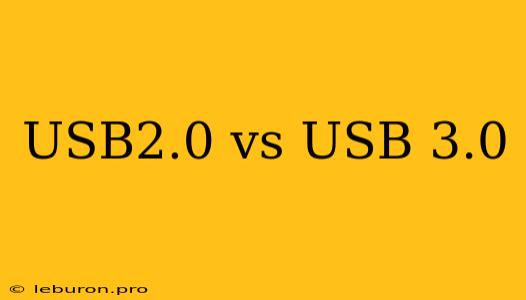The evolution of technology has brought us a plethora of advancements, and one such advancement is the development of faster and more efficient data transfer protocols. The Universal Serial Bus (USB) has revolutionized the way we connect devices to our computers, and its various versions have significantly impacted our daily lives. Two of the most prominent versions are USB 2.0 and USB 3.0, each offering distinct benefits and limitations. In this article, we'll delve into the differences between USB 2.0 and USB 3.0, exploring their speeds, compatibility, and implications for various applications.
USB 2.0: The Foundation of Connectivity
USB 2.0, introduced in 2000, served as a significant upgrade over its predecessor, USB 1.1. It standardized the way devices communicated with computers, offering faster data transfer rates and improved power delivery. USB 2.0 quickly became ubiquitous, connecting everything from keyboards and mice to external hard drives and printers.
Advantages of USB 2.0:
- Widespread Compatibility: USB 2.0 became the standard for most devices, ensuring compatibility with a wide range of computers and peripherals.
- Cost-Effectiveness: The technology's maturity and widespread use led to lower production costs, making USB 2.0 devices affordable for consumers.
- Reliable Performance: While not as fast as its successor, USB 2.0 provided reliable data transfer speeds for common tasks.
Limitations of USB 2.0:
- Slower Data Transfer: With a theoretical maximum speed of 480 Mbps, USB 2.0 struggled to keep pace with the increasing demands of high-resolution video and large files.
- Power Limitations: While USB 2.0 could provide more power than its predecessor, it still faced limitations when powering demanding devices like external hard drives.
USB 3.0: The Speed Demon
USB 3.0, released in 2008, marked a significant leap forward in data transfer technology. It introduced a new generation of connectors and protocols, enabling significantly faster speeds and improved power delivery.
Advantages of USB 3.0:
- Blazing Fast Transfer Speeds: With a theoretical maximum speed of 5 Gbps, USB 3.0 was significantly faster than USB 2.0, allowing for rapid transfer of large files, such as high-resolution images, videos, and backups.
- Enhanced Power Delivery: USB 3.0 increased the power output, enabling the use of more demanding peripherals, such as external hard drives with higher storage capacities.
- Backward Compatibility: USB 3.0 devices were backward compatible with USB 2.0 ports, ensuring that users could still connect older devices.
Limitations of USB 3.0:
- Higher Cost: The advanced technology and higher manufacturing costs made USB 3.0 devices more expensive than USB 2.0 devices.
- Limited Compatibility: While backward compatible with USB 2.0, not all devices and computers were initially equipped with USB 3.0 ports.
Choosing Between USB 2.0 and USB 3.0
The decision of whether to use USB 2.0 or USB 3.0 depends on individual needs and applications.
USB 2.0 remains a suitable option for:
- Everyday tasks: Transferring files, connecting keyboards, mice, printers, and other low-bandwidth devices.
- Budget-friendly options: USB 2.0 devices are generally more affordable than their USB 3.0 counterparts.
USB 3.0 is ideal for:
- High-speed data transfers: Transferring large files, such as videos, photos, and backups, quickly.
- High-demand peripherals: Powering external hard drives, SSDs, and other high-performance devices.
The Evolution Continues: USB 3.1 and USB 3.2
The evolution of USB technology didn't stop with USB 3.0. USB 3.1 and USB 3.2 introduced further advancements in speed and power delivery, pushing the boundaries of data transfer even further.
USB 3.1:
- Faster Speeds: USB 3.1 introduced two specifications: USB 3.1 Gen 1 (5 Gbps) and USB 3.1 Gen 2 (10 Gbps).
- Smaller Connectors: USB 3.1 also introduced the Type-C connector, which offered a smaller and more versatile design.
USB 3.2:
- Enhanced Speeds: USB 3.2 built upon USB 3.1, with USB 3.2 Gen 2x2 achieving speeds up to 20 Gbps.
- More Efficient Power Delivery: USB 3.2 improved power delivery capabilities, allowing for faster charging of devices and powering even more demanding peripherals.
The Future of USB
USB technology continues to evolve, with advancements in speed, power delivery, and connector design. As technology progresses, we can expect even faster data transfer rates and more powerful capabilities from USB ports.
Conclusion
USB 2.0 and USB 3.0 represent significant milestones in the evolution of data transfer technology. USB 2.0 laid the foundation for widespread connectivity, while USB 3.0 revolutionized data transfer speeds. While USB 3.0 provides undeniable advantages in speed and power, USB 2.0 remains relevant for specific applications. Ultimately, the choice between USB 2.0 and USB 3.0 depends on individual needs, budgets, and the specific devices being connected. As USB technology continues to evolve, we can expect even more innovative solutions in the future, further enhancing our connectivity experience.
